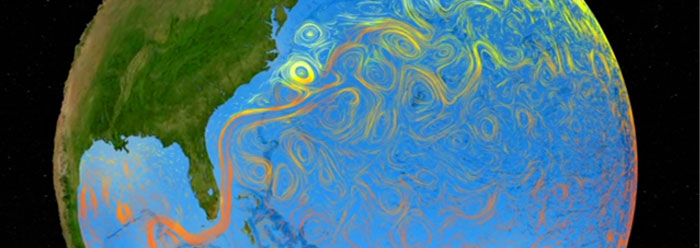Virtually everybody knows that the world's oceans have currents. But few know who first discovered them, why they are important, or what can be gained by mapping them in greater detail. NASA's Aquarius satellite is collecting related data from the world's oceans, and a recent NASA video highlighted the vital importance of its currents.
Life on earth depends on the continuous movement of ocean water to mix nutrients both horizontally and vertically, otherwise ocean life—and, by extension, life elsewhere on earth—would not survive. The vast majority of the planet's breathable oxygen is generated by marine algae, which are fueled by this mixing.
Ocean currents have complicated causes. The video, while highlighting NASA's Aquarius satellite project, also explained that "at the ocean surface, currents are primarily driven by winds. Deep below the surface, however, currents are controlled by water density, which depends on the temperature and salinity of the water."1 Aquarius detects sea surface salinity data from the world's oceans—and not just from shipping lanes, from which most data have historically been obtained.2
Water becomes denser and saltier as it cools, and as a result it sinks below less dense waters. The NASA video stated, "This globally interconnected process of overturning circulation occurs in all ocean basins and helps to regulate earth's climate."1
Thus, ocean currents feed vital organisms and help govern climate, including the distribution of vital rain. But these things were known in the 1800s. Matthew Maury, the father of modern oceanography, was the first to establish the causes and courses of marine currents. He rejected contemporary but lesser theories of what causes currents, including the idea that they are forced by river runoff. In 1855, Maury wrote, "Hence we say we know that the sea has its system of circulation, for it transports materials for the coral rock from one part of the world to another."3
Maury also recognized the importance of ocean circulation to earth's climate. Concerning animals that can build solid shells out of miniscule materials in solution, he wrote: "For to them, probably, has been allotted the important office of assisting in giving circulation to the ocean, of helping to regulate the climates of the earth, and of preserving the purity of the sea."4
Unlike NASA's Aquarius project, Maury rightly credited God, not nature, for establishing the ocean's currents. For example, he wrote that "reason assures us that they move in obedience to some law of Nature, be it recorded down in the depths below, never so far beyond the reach of human ken; and being a law of Nature, we know who gave it, and that neither chance nor accident had any thing to do with its enactment."5
His life's work was inspired by Psalm 8:8, which refers to "the paths of the seas."6 Thus, the ocean currents illustrated in the recent NASA video clearly testify to the paths of the seas with which Matthew Maury and the psalm's writer, King David, were acquainted. God still oversees His earth.
References
- Aquarius Ocean Circulation. NASA/Goddard Space Flight Center video. Posted on nasa.gov, accessed September 15, 2011.
- Overview: Mission Basics. Aquarius Sea Surface Salinity from Space fact sheet. NASA/Goddard Space Flight Center. Posted on aquarius.nasa.gov, accessed September 15, 2011.
- Maury, M. F. 1855. The Physical Geography of the Sea, 2nd ed. New York: Harper & Brothers, 153.
- Ibid, 165.
- Ibid, 124-125.
- Gish, D. 1991. Modern Scientific Discoveries Verify the Scriptures. Acts & Facts. 20 (9). [link: ]
Image credit: NASA/Goddard Space Flight Center
* Mr. Thomas is Science Writer at the Institute for Creation Research.
